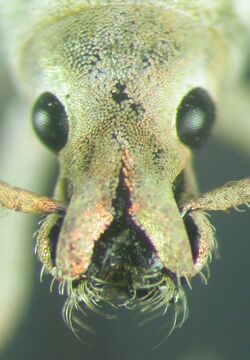Biology:Compsus
| Compsus | |
|---|---|

| |
| Compsus sp. | |
| Scientific classification | |
| Domain: | Eukaryota |
| Kingdom: | Animalia |
| Phylum: | Arthropoda |
| Class: | Insecta |
| Order: | Coleoptera |
| Infraorder: | Cucujiformia |
| Family: | Curculionidae |
| Tribe: | Eustylini |
| Genus: | Compsus Schönherr, 1823 |
| Type species | |
| Compsus gyllenhali Schönherr, 1823
| |
| Species | |
|
See text | |
Compsus is a genus of broad-nosed weevils in the family Curculionidae, distributed across the Americas, primarily in northern South America.[1]
Taxonomy
The genus Compsus was first named by Carl Johan Schönherr in 1823: col. 1140.[2] It belongs to the subfamily Entiminae, tribe Eustylini and to the so-called "Compsus genus complex".[3]
A key to identify species was provided by Hustache in 1938 (in French),[4] which was translated to English and adjusted by O'Brien and Peña.[5]
Description
Broad-nosed weevils of moderate size (approx. 7–12 mm), most of them uniformly covered by scales of variable coloration ranging from white to metallic green, pink, and blue.
Many morphological features of Compsus overlap with those of related eustyline genera including Exorides, Eustylus, and Oxyderces, composing the so-called "Compsus genus complex".[3]
Distribution
Argentina , Bolivia, Brazil , Colombia, Ecuador, French Guiana, Guyana, Peru, Suriname, Venezuela; Costa Rica, Guatemala, Mexico, Nicaragua, Panama; Guadeloupe, Jamaica, NC, SE, SW United States .[1][6]
Interaction with other species
Two species in the genus (Compsus obliquatus and Compsus viridivittatus) are considered pests of Citrus in Colombia.[5]
Compsus auricephalus, known as the golden-headed weevil is the species with northernmost distribution and has association with 46 plant species in 23 families.[3]
Species
The genus contains 101 described species.[7][6]
References
- ↑ 1.0 1.1 Alonso-Zarazaga, M. A.; Lyal, C. H. C. (1999). A world catalogue of families and genera of Curculionoidea (Insecta: Coleoptera) excluding Scolytidae and Platypodidae. Barcelona, Spain: Entomopraxis. pp. 315 pp. https://weevil.myspecies.info/sites/weevil.info/files/Alonso-Zarazaga%20%26%20Lyal,%201999_World%20Catalogue%20%28searchable%29.pdf.
- ↑ Schönherr, C. J. (1823). Curculionides [Tabula synoptica familiae Curculionidum]. Isis von Oken. pp. 1132–1146. https://biodiversitylibrary.org/page/13257284.
- ↑ 3.0 3.1 3.2 Girón, J. C.; Chamorro, M. L. (2020-09-07). "Variability and distribution of the golden-headed weevil Compsus auricephalus (Say) (Curculionidae: Entiminae: Eustylini)" (in en). Biodiversity Data Journal 8: e55474. doi:10.3897/BDJ.8.e55474. ISSN 1314-2828. PMID 32733144.
- ↑ Hustache, A. (1938). "Compsus sud-américains (Coleoptera Curculionidae)". Bulletin de la Société Entomologique de Belgique 78: 67–118.
- ↑ 5.0 5.1 O’Brien, C. W.; Peña, J. (2012). "Two species of Compsus Schoenherr, new citrus pests from Colombia (Coleoptera: Curculionidae: Entiminae)". Insecta Mundi 0227: 1–13. https://digitalcommons.unl.edu/insectamundi/736.
- ↑ 6.0 6.1 Wibmer, G. J.; O’Brien, C. W. (1986). "Annotated checklist of the weevils (Curculionidae sensu lato) of South America (Coleoptera: Curculionoidea)". Memoirs of the American Entomological Institute 39: 1–563.
- ↑ O’Brien, C. W.; Wibmer, G. J. (1982). "Annotated checklist of the weevils (Curculionidae sensu lato) of North America, Central America, and the West Indies (Coleoptera: Curculionoidea)". Memoirs of the American Entomological Institute 34: 1–382.
External links
Wikidata ☰ Q14924383 entry
 |

